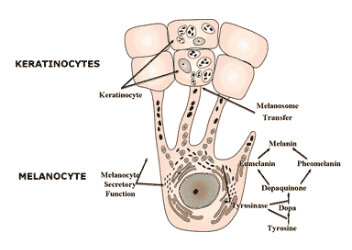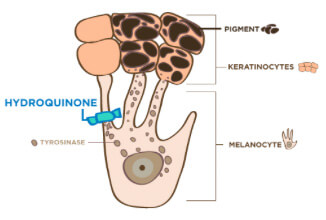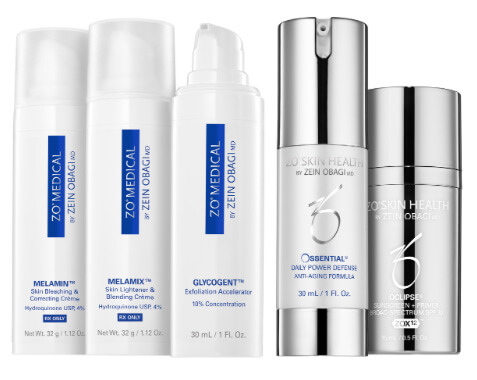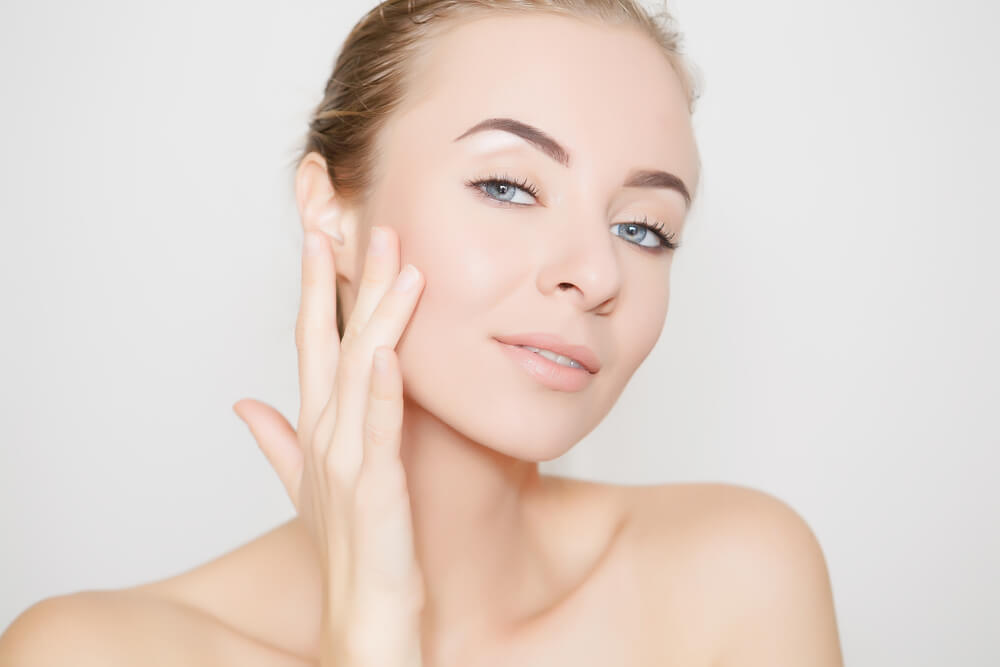
Sun spots, age spots and livers spots, acne stains, pregnancy mask and melasma…call them what you want, but these conditions all lump into one simple category: hyperpigmentation. So, what’s the deal? Where did this come from? Simply put, hyperpigmentation is the result of an overproduction of melanin in a localized area stimulated either by sun, trauma or hormones. Melanin is found throughout the body and is responsible for the colour of our hair, eyes and skin. Fair skinned people tend to make very little melanin while darker skinned individuals make more. Melanin is produced by specialized cells called melanocytes, which are among the cells primarily found in the outermost layer of the skin. After melanin is produced, it spreads and is evenly distributed within the skin. However, when the melanocytes get damaged or become unhealthy in some way, the production process can go into overdrive, resulting in an uneven skin tone.

We could go on and on about the process of hyperpigmentation and its many forms but today we’re going to focus on the three most common types: sun damage, melasma and post-inflammatory hyperpigmentation. We’ll also chat about how you can treat them at home with our miracle ingredient of the month, hydroquinone. But wait! Don’t run and hide just yet. We know hydroquinone sounds like a big scary chemical and maybe you’ve even heard some horror stories but rest assured, our hydroquinone is Health Canada approved. It’s absolutely safe to use with the expert guidance of your NuAGE Laser & Skin Care specialist by your side. Now, let’s learn about the differences among the three common forms of hyperpigmentation.
Sun Damage
First on the list is the most common type of hyperpigmentation where the damage is caused by overexposure to the sun. Let’s get one thing straight off the bat: There is absolutely no such thing as a “healthy tan.” Got it? Good. We’re sorry to break it to you but that golden glow that you work so hard for every year is actually damage and cell death. Even if you’re not burning, your bronze is still harming cells and it will change them forever. A tan is actually your body’s natural defense mechanism against the sun. It’s trying to protect itself from something it knows is damaging on a cellular level – pretty crazy, right?
Sun damage will generally appear on high points of the face and body. The most common areas to see hyperpigmentation of this nature are the forehead, cheeks, nose, tops of the shoulders and chest and the back of the hands. Once a melanocyte has been excited by a little too much UV exposure, it will continue to overproduce melanin in a certain area, thus resulting in freckles and spots of darker pigment. The longer this overexposure and excitement goes on, the deeper the damage becomes making it likely you’ll require a more intense treatment like IPL to remove it for good.
Book A Free Consultation in Our Vancouver Clinic Today
Melasma
Next up, is hormonally-triggered hyperpigmentation. This is often referred to as “pregnancy mask,” or melasma, because it’s typically caused or exacerbated by the hormonal fluctuations that occur thanks to pregnancy, oral contraceptives, HRT (hormone replacement therapy) and some medications.
This type of pigmentation looks more like patches and is often in a very symmetrical pattern and is most commonly seen across the cheeks and nose, hence the “mask.” It can also show up on the forehead and above the upper lip. Melasma is caused by overactive melanocytes (the melanin-producing cells) in the skin. These cells become hypersensitive to hormones and UV exposure, which causes the excessive amount of pigmented cells to “spill out” and accumulate in what looks like patches.
For some, melasma will resolve itself once hormone levels rebalance and return to normal, such as postpartum, however, for others, this condition can be frustratingly persistent. Because melasma can be stimulated by heat, using laser to treat it is not the ideal or recommended method. Your best options are hydroquinone or microneedling.
Post-Inflammatory Hyperpigmentation
Here’s a form of hyperpigmentation we’ve all experienced at some time or another but whether or not it stuck around for a while is another story! We see post-inflammatory hyperpigmentation (PIH) most often after acne but it can be caused by any form of trauma to the skin, including cuts, scrapes, blisters and burns, ingrown hairs/folliculitis and even following an allergic reaction like hives. Once our body has identified a trauma, it stimulates our inflammatory response, which is there to help the body heal itself after injury or infection.
Sometimes, though, the signals get mixed and our body thinks the healing is complete before the job is really done. This leaves us with red and brown “stains” on the skin where the lesion or injury originally occurred. You can think of these stains as a scab under the skin. After the red blood cells rushed to the site during the inflammatory response, some weren’t taken away in time by our lymphatic cells and were then allowed to coagulate and harden around the inflammation, resulting in the red spot. In the case of an open lesion (like a cut or blemish), if the area is exposed to UV rays, it can turn into a harder-to-treat brown spot.
As this form of hyperpigmentation tends to be the most superficial, there are many options for treatment, such as microdermabrasion, chemical peels, Laser Genesis, IPL, microneedling or fraxel laser. However, being that it is superficial, we’re all about treating PIH with ingredients like retinol and hydroquinone.
What is Hydroquinone?
Ok, so we’ve already told you that hydroquinone is one of the most powerful ingredients in skincare targeting pigmentation but how exactly does it work? Well, there’s an enzyme known as tyrosinase, which is needed by the melanocyte in order to be able to produce melanin. Hydroquinone works by interfering with the tyrosinase enzyme and preventing the melanocyte from getting down to business. Make sense?

Here at your favorite Vancouver skincare destination, we love, love, love Dr. Obagi’s Multi-Therapy Hydroquinone System because it combines hydroquinone, the gold standard ingredient for reversing pigmentation, with other skincare heavyweights like retinol and vitamin C. Retinol will work on pigmentation by speeding up the cell turnover rate, which moves the pigmented cells up and out faster (resurfacing), while vitamin C (specifically L-Ascorbic acid at 10% or higher) will help to lighten and fade the pigmentation, overall brighten the skin and make it stronger, preventing future damage. On top of that, adding in an alpha-hydroxy acid like glycolic acid will aid in sloughing off superficial cells on the skin’s surface, thereby helping to further fade pigmentation and create a smooth texture.
Let’s break down each of the amazing products within the Multi-Therapy Hydroquinone System:

Melamin Skin Bleaching & Correcting Crème *PRESCRIPTION ONLY*
A highly potent Rx bleaching solution that gradually lightens and inhibits hyperpigmentation by altering the natural process that causes cell damage. Specifically created to help even skin tone by slowing melanin production, it dramatically reduces the appearance of chloasma, melasma, freckles and sun damage.
BENEFITS
- Gradual skin bleaching of hyperpigmented skin conditions – chloasma, melasma, freckles and other unwanted hyperpigmentation
- 4% hydroquinone suppresses pigment production
- Helps reduce irritation associated with hydroquinone
- Hydrates newly exposed skin
Glycogent Exfoliation Accelerator
A unique glycolic and lactic acid complex that assists in the removal of dead cells for ultimate skin surface renewal
BENEFITS
- Provides gentle, yet effective exfoliation of dead skin cells to increase cell regeneration
- Helps soothe and support skin with advanced anti-irritant moisturizing properties
- Antioxidants help prevent future damage
Melamix Skin Lightener & Blending Crème *PRESCRIPTION ONLY*
Formulated specifically to be used with tretinoin; contains 4% hydroquinone, which is used for the treatment of pigmentation (must be mixed in equal parts with Retamax).
BENEFITS
- Helps even skin tone
- Helps optimize delivery of active ingredients
- Helps reduce irritation associated with hydroquinone
- Hydrates newly exposed skin
- Vitamin E and butylated hydroxytoluene provide antioxidant properties
Ossential Daily Power Defense
A lightweight lotion designed to help protect and repair all skin types; a must for everyone
BENEFITS
- Provides antioxidant protection to combat free radical damage
- Helps tighten and firm the skin
- Promotes skin health
- Helps support skin’s natural mechanism to repair damage and protect against future skin damage
Oclipse-C SPF 50
Lightweight, non-irritating mineral sunscreen for the most sensitive skin types and post-procedure skin. Offers broad-spectrum protection against UVA, UVB, IR-A and high-energy visible (HEV) light
BENEFITS
- Offers daily multi-defense protection from UVA, UVB and HEV light
- ZOX12 complex provides antioxidant protection against free radical damage and the harmful effects of infrared (IR-A) rays
- Ultra-milk formula suitable for even the most sensitive skin types
- Soothes the skin and helps to minimize inflammation
- 5.7% titanium dioxide and 4.9% zinc oxide
In addition to this system, you will also need Retamax alongside a great cleanser, scrub and oil control toner. Here’s how it all goes together:
| STEP | PRODUCT | AM | PM | DIRECTIONS |
|---|---|---|---|---|
| 1. Cleanse | Oily: Oilacleanse Dry: Exfoliating Cleanser All: Hydrating Cleanser | Apply a pea-sized amount to damp skin and massage in for 40-60 seconds to stimulate lymphatic drainage and blood circulation. | ||
| 2. Scrub | Oily: Vitascrub Dry: Exfoliating Polish | Apply a pea-sized amount to dry skin and massage scrub in for 40-60 seconds. Allow to sit for 1 minute as hydrators and oils are absorbed. | ||
| 3. Oil Control | Oily: Cebatrol or TE Pads Dry: Balatone | Use 1/2 of a pad morning and night. Avoid eye area and do not rinse off. | ||
| 4. Treat | C-Bright | Apply a pea-sized amount all over to clean, dry skin before Melamin in the AM and before Melamix & Retamax in the PM. | ||
| 5. Treat | Melamin | Apply a pea-sized amount all over. | ||
| 6. Treat | Glycogent | Apply a pea-sized amount all over. Use every other day as tolerated. | ||
| 7. Treat | Daily Power Defense | Apply in the evening after Melamin (before Melamix + Retamax) to help strengthen the skin. | ||
| 8. Treat | Melamix + Retamax | Mix equal parts of Melamix and Retamax and apply all over. Begin use only 1-2x per week. Slowly increase use as tolerated. | ||
| 9. Protect | Sun Protection | Apply generously. Reapply every 1-2 hours. |
If you’re ready to rid yourself of hyperpigmentation for good, ZO Medical’s Multi-Therapy Hydroquinone System is the first place to start. However, if hydroquinone isn’t your cup of tea, ZO still has solutions for you, including Brightenex (0.5%-1% retinol), Brightalive (non-retinol, non-hydroquinone), which contain natural lightening ingredients such as kojic acid and licorice root extract, and, of course the beloved C-Bright Serum and Glycogent.
Since we know that all pigmentation disorders and conditions are caused or exacerbated by UV exposure, we also know how important it is to shield our skin with a good sunscreen of at least SPF 30 every day! Protect the investment you make when you’re reversing hyperpigmentation, whichever route you choose, by preventing it from coming back.
Now that you have tons of information on kicking your hyperpigmentation to the curb, book your complimentary skin health consultation with a NuAGE Laser expert. We’ll create a customized plan tailored to meet your complexion needs. We offer a complete range of Vancouver laser procedures, skin care solutions and cutting-edge products, including the ZO™ Skin Health line. Say farewell to spots, splotches, stains and patches and show off even, bright skin instead.


